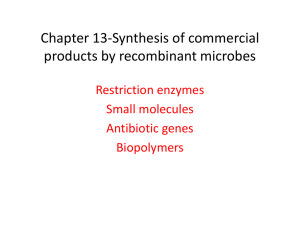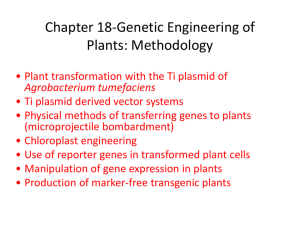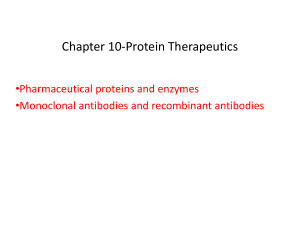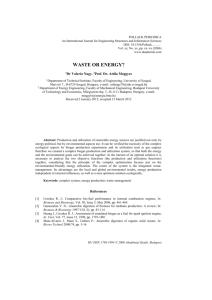Bioremediation & Biomass Utilization: Presentation
advertisement
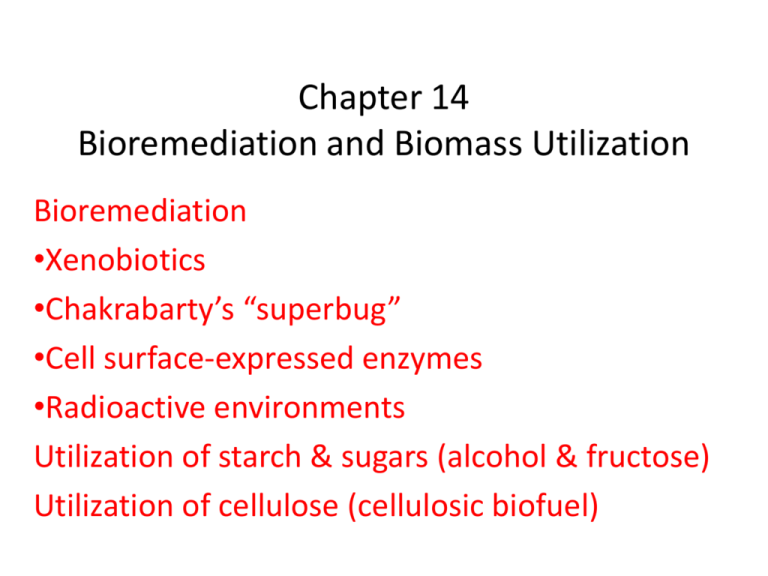
Chapter 14 Bioremediation and Biomass Utilization Bioremediation •Xenobiotics •Chakrabarty’s “superbug” •Cell surface-expressed enzymes •Radioactive environments Utilization of starch & sugars (alcohol & fructose) Utilization of cellulose (cellulosic biofuel) Bioremediation and Xenobiotics • Bioremediation-The use of biological agents to remove toxic wastes from the environment. • Xenobiotics-Unnatural chemicals such as herbicides, pesticides, refrigerants, solvents, and other organic compounds. Chapter 14 Bioremediation and Biomass Utilization Table 14.1 Pseudomonas are soil bacteria that degrade xenobiotics to catechol or protocatechuate thanks to genes on their plasmids. Molecular Biotechnology: Principles and Applications of Recombinant DNA, Fourth Edition Bernard R. Glick, Jack J. Pasternak, and Cheryl L. Patten Copyright © 2010 ASM Press American Society for Microbiology 1752 N St. NW, Washington, DC 20036-2904 Chapter 14 Bioremediation and Biomass Utilization Figure 14.5 Chakrabarty et al. (1980) developed and patented a “superbug” that degraded petroleum (camphor, octane, xylene, and naphthaline) by plasmid transfers. Molecular Biotechnology: Principles and Applications of Recombinant DNA, Fourth Edition Bernard R. Glick, Jack J. Pasternak, and Cheryl L. Patten Copyright © 2010 ASM Press American Society for Microbiology 1752 N St. NW, Washington, DC 20036-2904 Chapter 14 Bioremediation and Biomass Utilization Figure 14.11 Figure 14.12 Expressing a Pseudomonas or Flavobacterium organophosphorus hydrolase (opd) gene fused to a lipoprotein gene at the E. coli cell surface to degrade organophosphate pesticides. Molecular Biotechnology: Principles and Applications of Recombinant DNA, Fourth Edition Bernard R. Glick, Jack J. Pasternak, and Cheryl L. Patten Copyright © 2010 ASM Press American Society for Microbiology 1752 N St. NW, Washington, DC 20036-2904 Chapter 14 Bioremediation and Biomass Utilization Figure 14.13 Deinococcus radiodurans is naturally resistant to high levels of radiation (given its enhanced DNA repair system) and hence an ideal bacteria to express bioremediating proteins in toxic, radioactive environments. Molecular Biotechnology: Principles and Applications of Recombinant DNA, Fourth Edition Bernard R. Glick, Jack J. Pasternak, and Cheryl L. Patten Copyright © 2010 ASM Press American Society for Microbiology 1752 N St. NW, Washington, DC 20036-2904 Chapter 14 Bioremediation and Biomass Utilization Figure 14.16 Biomass (e.g., starch) is used to generate alcohol and fructose thanks largely to the action of 3 key enzymes. Molecular Biotechnology: Principles and Applications of Recombinant DNA, Fourth Edition Bernard R. Glick, Jack J. Pasternak, and Cheryl L. Patten Copyright © 2010 ASM Press American Society for Microbiology 1752 N St. NW, Washington, DC 20036-2904 Chapter 14 Bioremediation and Biomass Utilization Figure 14.25 Cellulose is composed of b-1,4 linked glucose and can be used for biofuel (ethanol) if it can be extracted from the plant cell wall and broken down into glucose residues. Molecular Biotechnology: Principles and Applications of Recombinant DNA, Fourth Edition Bernard R. Glick, Jack J. Pasternak, and Cheryl L. Patten Copyright © 2010 ASM Press American Society for Microbiology 1752 N St. NW, Washington, DC 20036-2904 The Plant Cell Wall a | Cell wall containing cellulose microfibrils, hemicellulose, pectin, lignin and soluble proteins. b | Cellulose synthase enzymes are in rosette complexes, which float in the plasma membrane. c | Lignification occurs in the S1, S2 and S3 layers of the cell wall. Cellulosic Ethanol Production and Research Challenges This figure depicts some key processing steps in a future large-scale facility for transforming cellulosic biomass (plant fibers) into biofuels. Three areas where focused biological research can lead to much lower costs and increased productivity include developing crops dedicated to biofuel production (see step 1), engineering enzymes that deconstruct cellulosic biomass (see steps 2 and 3), and engineering microbes and developing new microbial enzyme systems for industrialscale conversion of biomass sugars into ethanol and other biofuels or bioproducts (see step 4). Biological research challenges associated with each production step are summarized in the right portion of the figure. Potential Bioenergy Crops
